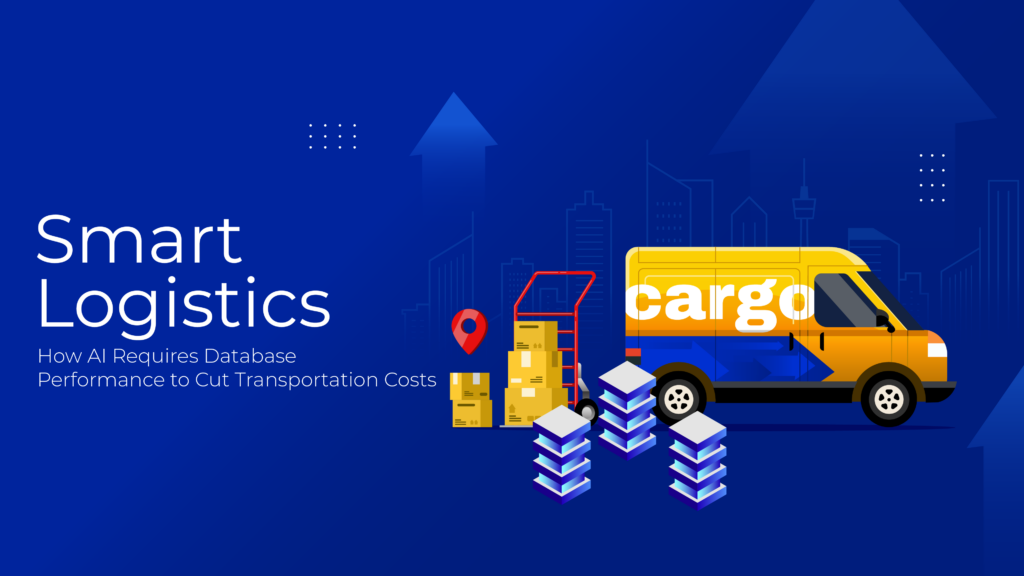

The latency alert explodes on the dashboard. Almost simultaneously, the head of operations calls, frustrated: the routing system is slow, delaying the dispatch of hundreds of vehicles. The developers say the code is optimized. The infrastructure team guarantees that the network and servers are normal. And in the midst of this blame game are the DevOps, SREs, and DBAs, buried in logs and metrics, trying to find the root cause of a problem that is already costing thousands of dollars per minute.
In logistics 4.0, the efficiency of a product’s delivery is a direct reflection of the efficiency of its data delivery. A millisecond delay in the database can create a cascading effect that paralyzes an entire fleet.
The promise of smart logistics, with its ability to cut transportation costs by up to 30% using Artificial Intelligence, is incredibly attractive to the business. But for the technical teams who need to build and maintain the foundation of this intelligence, the reality is an unprecedented challenge of scale, speed, and data complexity. It’s not just about collecting GPS data; it’s about processing a massive volume of information in real time from sensors, traffic APIs, management systems, and predictive models. And at the neurological center of this entire operation, where performance is non-negotiable, is the database.
The Data Explosion in Logistics 4.0: The Hidden Challenge Behind Efficiency
Modern logistics has evolved from a discipline of spreadsheets and maps into a real-time data ecosystem. Every vehicle, every package, every distribution center is a continuous source of information. A company’s ability to compete depends on its ability to capture, process, and act on this data faster than the competition.
Where Does the Data Come From? The Connected Logistics Ecosystem
The complexity for data and operations teams comes from the variety and velocity of the information sources that need to be integrated and analyzed:
- Vehicle Telemetry Data (IoT): GPS, speed, fuel consumption, container temperature, engine fatigue data, and even driver behavior.
- Transportation Management Systems (TMS): Route planning, fleet management, dock scheduling, and load optimization.
- Warehouse Management Systems (WMS): Inventory levels, product location, picking and packing status.
- Real-Time External Data: Traffic APIs (like Waze and Google Maps), weather conditions, fuel prices, and even news about road closures.
- Customer Data: Orders, promised delivery windows, and real-time tracking (last mile).
This torrent of data is the fuel for AI algorithms, but it also represents a brutal workload for the database infrastructure, which must ensure the ingestion, processing, and querying of this information with minimal latency.
The Central Role of the Database in Logistics Optimization
Artificial Intelligence in logistics is not a magic trick. It consists of complex algorithms that depend on fast, reliable access to accurate data. Any bottleneck in the database invalidates the effectiveness of these algorithms and turns the investment in AI into a cost with no return.
Real-Time Route Optimization: Milliseconds Away from Savings
The heart of savings in logistics lies in dynamic routing. an AI algorithm can recalculate a vehicle’s route in transit to avoid an accident that just happened. To do this, it needs to query the vehicle’s location, traffic API data, the next scheduled deliveries, and cargo restrictions in real time. Each of these data points is a database query.
Now, multiply this by a fleet of 5,000 vehicles, each requiring a recalculation every 5 minutes. We are talking about millions of complex transactions per hour. For a DBA or SRE, the challenge is to ensure that the execution plan for each of these queries is maximally optimized. A single poorly indexed query can add 500 milliseconds of latency. It seems small, but at scale, it means the system’s “real-time decisions” are actually being made based on data that is several minutes old, resulting in inefficient routes and unnecessary fuel consumption.
Inventory Management and Demand Forecasting: The Data Consistency Challenge
AI is also used to forecast product demand in different regions, optimizing inventory levels and avoiding both stockouts (lost sales) and overstocking (storage costs). These machine learning models analyze historical sales data, seasonality, local events, and market trends.
The accuracy of these forecasts depends on the quality and speed with which the data is fed to the model. A slow database infrastructure can delay the updating of sales data, causing the model to work with outdated information. Ensuring consistency and performance in a distributed data environment, which often involves operational (OLTP) and analytical (OLAP) databases, is a complex task for data engineering teams.
Traceability and Visibility (Last-Mile): The Pressure of the Customer Experience
The final stage of delivery, the “last mile,” is the most expensive and the most critical for customer satisfaction. Today, consumers expect to be able to track their orders in real time, with the same precision as a ride-sharing app.
This generates an immense read and write workload on the database. Each status update from a delivery driver is a write. Every time a customer opens the app to track, it’s a read. For a company with thousands of simultaneous deliveries, this translates into a massive demand for performance and scalability, especially during peaks like Black Friday. A failure here not only generates operational costs but also causes irreparable damage to the brand’s reputation.

Why Does Traditional Monitoring Fail? The Need for Observability in Logistics
Faced with this complexity, traditional monitoring tools are insufficient. A dashboard showing the database server’s CPU usage at 90% is just a symptom. It doesn’t answer the critical questions:
- Which specific application, user, or query is causing this load?
- Is the slowness caused by a missing index, stale statistics, or an inefficient query execution plan?
- Is this behavior a recurring pattern or an isolated anomaly?
This reactive approach leaves DevOps and SRE teams in a constant state of firefighting. Observability, on the other hand, provides the context needed to understand the why behind the what. By correlating metrics, logs, and traces, observability allows you to trace the lifecycle of a request from the application down to the deepest level of the database, identifying the root cause of a performance problem quickly and accurately.
dbsnOOp: The Observability Platform for Smart Logistics
It is precisely to bridge this gap between the demand for AI performance and the limitations of traditional tools that dbsnOOp was created. dbsnOOp is not just a monitoring tool; it is an intelligent observability platform that uses Artificial Intelligence itself to ensure the health and performance of the data infrastructure that powers your logistics.
From Alert to Diagnosis: Automation with AI for Troubleshooting
Instead of just alerting on a symptom (high latency), dbsnOOp goes straight to the root cause. Its AI continuously analyzes query execution plans, resource consumption, and database behavior to proactively identify bottlenecks. When a problem is detected, the platform not only informs you which query is slow but also explains why and suggests the necessary optimization, often providing the ready-to-implement code. This reduces the mean time to resolution (MTTR) from hours to minutes.
Performance and Security in Cloud and Hybrid Environments
Modern logistics infrastructure is often hybrid, with legacy on-premises systems and new AI and analytics applications in the cloud. dbsnOOp offers a unified view of all your databases (SQL Server, Oracle, PostgreSQL, MySQL), regardless of where they are running. This eliminates information silos and allows SRE and DevOps teams to manage the performance and security of the entire data ecosystem from a single point.
Empowering DevOps and SRE Teams to Focus on Innovation
By automating the diagnosis of performance problems, dbsnOOp frees your most expensive talent from the vicious cycle of reactive troubleshooting. Instead of spending the day analyzing logs, your team can focus on projects that add real value to the business, such as improving AI models, developing new customer features, or optimizing the architecture for the future. dbsnOOp transforms database management from a reactive cost center into a proactive enabler of innovation.
The promise of cutting 30% of transportation costs with AI is real, but it will not be achieved without a solid, performant, and, above all, observable data foundation. Trying to operate a smart logistics system without a deep view of your database’s performance is like trying to navigate an entire fleet in a fog, using only a broken compass. dbsnOOp is the radar and GPS system that your technical team needs to navigate safely and efficiently, ensuring that data always arrives at the right time.
Want to solve this challenge intelligently? Schedule a meeting with our specialist or watch a live demo!
Schedule a demo here.
Learn more about dbsnOOp!
Learn about database monitoring with advanced tools here.
Visit our YouTube channel to learn about the platform and watch tutorials.

Recommended Reading
- What does your company lose every day by not using AI?: This article expands the business case for AI adoption. If smart logistics can cut 30% of costs, this text shows the hidden losses in other areas of the company that are not yet using artificial intelligence to optimize operations and data.
- 5 hidden problems that Artificial Intelligence can solve in your industry: While we discuss route optimization, AI can solve even deeper challenges in your logistics operation. This article serves as inspiration, showing other problems you might not even know can be solved with the right application of AI.
- Outsourced 24/7 Monitoring: The foundation of smart logistics is the continuous availability of data. This article explores a service model that ensures the health of your database infrastructure without overburdening your internal team, a strategic complement to ensure your operation never stops.

